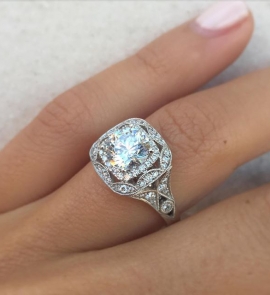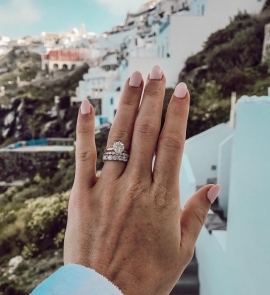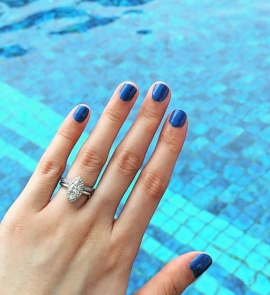Shopping for a diamond? Here’s everything you need to know about getting the biggest, best stone for your money.
The stress of proposing could be enough to send some guys into full-fledged panic mode. There’s a lot to consider: What’s her style? What’s her size? Will she say ‘yes’? How to do it, where to do it…the list goes on and on (please stay calm).
But equally as important as all that, you’ve got to ask yourself what’s your budget? If sticking to a budget is important to you, we’ve got some tips of the trade to help you get all that she wants—for less!
Make cut count
If you want a diamond that’s the best bang for your buck, a high-quality cut is the #1 thing to look for. While cut also alludes to the shape (i.e. round, oval, square) it actually refers to the quality of how the diamond was cut and affects the sparklyness of the stone. The higher the cut, the more blindingly bright and radiant your stone will be; which will ultimately help hide cost-saving blemishes that you won’t be able to see... unless you have a powerful microscope.
Once you land a good cut, you can cut down costs by making essentially unnoticeable sacrifices elsewhere.
Sacrifice on (some) specs
Now that you’ve got your cut in check, you can lower your requirements for color and clarity and still get a nearly perfect stone.
Color: For those of you who need a quick reminder of color, D is the most colorless, while a Z stone has the most yellow. If you have a good enough cut, you can go as low as a G-color stone. To most people, that amount of color difference isn’t very noticeable; especially when you account for all the white light a great cut produces. So, if you’re looking for a near colorless diamond without paying colorless diamond prices, go for the G/H color. You can even save more on the I-K colors, however, expect a bit more warmth (which isn’t necessarily a bad thing!!) unless you set it in a yellow-gold setting.
Clarity: This is the biggest cost-saving trick if you pay attention. First off, FL to VS1 are top-rated stones that typically mean your diamond won’t have any inclusions you can see with the naked eye. We’ve seen a lot of people brag about their FL stones, but all that really means is that you can’t see any inclusions under a MICROSCOPE! Depending on the shape, FL to VS1 clarities are nice because it’s essentially guaranteed you won’t be able to see any inclusions with the naked eye. But that “guarantee” will cost you.
If you’re trying to get keep some of that cash for the actual wedding (or cough cough… a bigger ring), you’ll want to look for an “eye clean” diamond in the VS2 to SI2 range. What this means is that the inclusions in the diamond are either in a location where the ring’s setting, or light from a great cut diamond completely hides it.
So, keep in mind, it’s possible that difference between a FL and a SI2 diamond might save thousand of dollars, but will only be noticeable under a powerful microscope. Hopefully your future bride doesn’t have a powerful microscope on hand so you can save thousands :-).
Metal makes a difference
While you should always keep in mind what she wants (what kind of jewelry does she normally wear?) we do have a couple of tricks to keep in mind when picking out the band metal.
- Yellow and rose gold help a diamond with a lower color grade look whiter and brighter because of the contrast.
- White gold looks exactly like platinum but is more affordable.
- 24K gold is actually quite soft and easily susceptible to damage, so you’re better off with a tougher (and cheaper) 14K or 18K gold band.
(See all Metals on JamesAllen.com)
Shape up
Popularity of a shape can also affect price. The more demand for a shape, the higher the cost.
Round stones have the highest demand, so jewelers can ask for a higher price. Princess stones, on the other hand have less demand and will typically cost less.
There are also certain shapes that just look…bigger. Emeralds, for example, face up and don’t have to be deep to be set. Same with some ovals and marquise cuts.
All settings aside
The #1 trick to making a diamond look bigger than it actually is? Put a halo setting around it. Several small diamonds surrounding your main stone packs a major visual impact since we tend to see the setting as part of the main piece. It’s a trick our eyes play on us so why not take advantage of that wonderful illusion?
(See all Settings on JamesAllen.com)
Size matters
Similar to how jewelers can ask for a higher price for cuts that are more in demand, they can also up the price for a carat size that’s in demand. For one reason or another, most people like a nice, round number when searching for a stone. But if you round up or down, you can save a few bucks. For example, instead of 1ct, consider a 0.9ct. Instead of a 2.5ct, check the price on a 2.4ct.
Buying bling in brief
Be smart about it, take your time, and remember that the money spent won’t be the make it or break it moment (we hope). The thought and sentiment behind the ring are what will matter most.
Learn more about the 4C’s here! And remember you can use our filters to find the perfect ring for your perfect girl.
(See all Engagement Rings on JamesAllen.com)






 Continue with Facebook
Continue with Facebook

Comments - 0 Comment